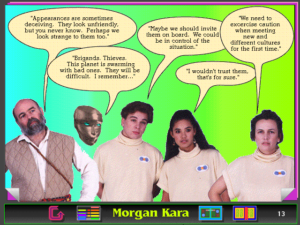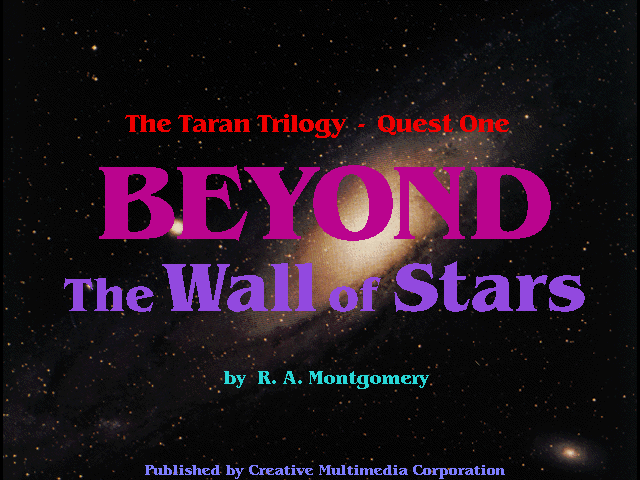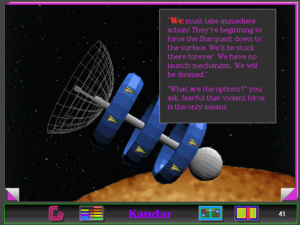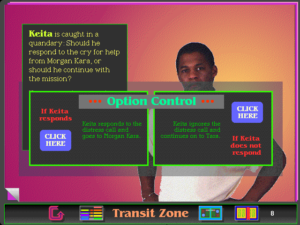Beyond the Wall of Stars 

Beyond the Wall of Stars sends you on a voyage to the far reaches of space. You’ve joined a scientific mission aboard the CSS Starquest to the distant planet Tara, which may hold the key to saving your dying homeworld. Along the way, there’s difficult choices to make. Do you answer an urgent distress call that sends you off your original course? When the crew’s morale collapses, do you instigate a mutiny against the commander?
You could think of it like being a choose your own adventure book, in a very literal sense. For one thing, it’s written, directed, and produced by one of the authors of the original Choose Your Own Adventure series, R. A. Montgomery. For another thing, the game acts like an actual, physical book. There’s a running page number in the bottom corner and a table of contents, and instead of saving your game, you place a “bookmark.”
It’s an apt comparison that also explains the limitations that the game runs into. With Beyond the Wall of Stars, Montgomery and his team noticeably struggle to make the transition from writing a print game to a digital game.
During the multimedia era in the 90s, one way that publishers thought about CD-ROMs was to treat them like digital books. They would adapt books into CD-ROMs by adding new features like annotations or video clips, or they would make new titles, using the same techniques, while experimenting with new forms of expression that weren’t possible in a print format. So it’s not unusual that following this trend, R. A. Montgomery would adapt the Choose Your Own Adventure format into a computer game. They were already games to begin with, but now they could have sound and animation! Most importantly, a digital book could do things with the narrative that couldn’t be done in a physical book, like remembering the choices you make across multiple story paths.
This is a great format for the campy sci-fi story Montgomery and his team wanted to tell. It’s the kind of story where people travel through space using a new technology called Hyperthought, and where the starships look like they came out of an episode of Thunderbirds. The motion graphics are hokey even for an early CD-ROM from 1992, but the unintentionally silly production, often at odds with the dramatic tone of the writing, actually makes it feel like the kind of mid-century space fantasy story that it aspires to be. Whoever designed the costumes for the live-action cast made some highly questionable fashion choices – one of the emissaries on the planet Morgan Kara is wearing a black blazer with military epaulets, a black-and-white striped neckerchief, gold chains, and khaki shorts (yikes), and their guns are clearly just Super Soakers – but honestly, that’s not a bad imitation of Star Trek.
It’s worth remembering that the Choose Your Own Adventure books were children’s novels and that this game isn’t too far removed from what R. A. Montgomery typically wrote. Beyond the Wall of Stars is not the most compellingly written story, but like the books it was inspired by, the narrative will branch out into wholly different storylines based on your actions. They can be serious choices – whether to overrule your commander – or excuses to throw you into an outlandish scenario. On Morgan Kara, a few innocuous choices early in the story mean you either end up tussling with a rebel group, or you follow crewmate Misa Zerring, who slowly recalls her early life as the princess of the despotic empire that now rules over this planet. Like the novels, it’s a broad but shallow story, but the diverging storylines let the game wheel out a wide range of hyper-colorful scenery and stop-motion graphics. At their best, they’re also a chance to learn more about the members of your crew.
At the end of each chapter, the story comes back together, and your crew heads off on their next adventure. Beyond the Wall of Stars is an episodic story, which means each chapter largely stands alone, but your actions to set up the groundwork for character arcs and consequences that could pay off further down the road, something that wouldn’t be easily possible in a printed book.
Then frustratingly, the game invents excuses to write off most of those storylines. The mutiny scene forces you to make difficult, meaningful decisions about the future of your mission, but regardless of your choices, the commander will suddenly die from mysterious, supernatural causes. Your advisor Karmah promises that they’ll deal with it later, so you can conveniently ignore the aftermath of the mutiny and keep going like it never happened. The game is defined by abrupt transitions like this, needing to pivot from one scenario to the next with as little baggage as possible.
(For my favorite example, one storyline ends with you receiving a magical stone that will help you in a time of need. It’s one of the few events in the game that carries over between chapters. Later on, when you’re confronted by a pack of monsters, you can activate the stone, which turns them all into kittens. The game hastily moves on and never speaks of this again.)
This is an issue that every narrative game has to face. There can’t be unlimited choices, and as the plot branches out, it becomes more difficult and expensive to continue following every story thread. It makes sense why the game would want to leave the previous stories behind, but the sleight of hand needed to get out of that commitment is blatant. Even if the Choose Your Own Adventure books had to tie up the plot this way, it feels like a cheap way out here.

Your crew wants to weigh in, including your AI companion Kryo, and almost everyone is rocking a short-sleeve beige turtleneck
On top of this, Beyond the Wall of Stars can be remarkably sloppy in places, and that implies bigger narrative design issues at play. There’s a number of errors, like the game forgetting which crew member you selected to be the commander. The Windows version of the game has even more issues: at the end of the chapter on the planet Kandar, the story accidentally goes in a loop.
But there is one huge, bizarre continuity issue we have to address. In the final chapter of the game, when you finally approach the Wall of Stars that serves as the gateway to Tara, you’re joined by your friend Scoot, the friendly space dragon.
Hold on, what?! We have never seen Scoot up to this point. There’s a chance, under a specific set of circumstances, that we could’ve seen a space dragon like Scoot in an earlier story branch, but the game doesn’t actually identify him because the scene apparently wasn’t finished and doesn’t have any text. Whether or not we saw that, Scoot shows up at the end, out of nowhere, playing around with the crew, as if he’s been on the ship the whole time. Were we supposed to meet him earlier? Was he an optional choice that wasn’t fully implemented? It feels like two drafts of the story were welded together, one with long-term, branching choices and one without.
The extent of these problems suggests that the developers were uncomfortable working in a digital format. This was R. A. Montgomery’s first video game, and as he tried to scope out how to tell a digital story, he fell back on the old habits of writing a print book instead. In that light, the features like the bookmarks and the page numbers feel like handholds, familiar features from an old format to grab onto.
The reason Beyond the Wall of Stars is a CD-ROM instead of a book probably just comes down to the commercial interests of its publisher, Creative Multimedia Corporation. The game has goofy multimedia visuals – and a surprisingly good soundtrack – but beyond that, it treats the CD-ROM format like it’s just a novelty. It borrows techniques from other interactive books, like pop-up definitions when you click on words, but they’re used sporadically without purpose. Executive producer John Calhoun from Creative Multimedia didn’t seem to know what to do with the game either, half-heartedly marketing it as an educational game to teach vocabulary and “scientific concepts,”1 whatever that means.
This was meant to be the first part in a trilogy, advertised as “Quest One of the Taran Trilogy” on the cover. As such, it’s incredibly short, and it ends on an abrupt cliffhanger, with Scoot the dragon and Misa Zerring kidnapped in space. It’s another sign that R. A. Montgomery wasn’t sure of the right way to resolve this story. At least he never had to.
References
1. Creative Multimedia Corp. introduces Beyond the Wall of Stars — a new Macintosh multimedia adventure by R.A. Montgomery. (1992, July 15). Business Wire. Retrieved from Factiva.





Ha, I’ve never expected to find a brand new review of this game in 2020. I received it among two others (one in an identical sleeve called The Magic Death) as a kid in the late 90s from a family friend. Really enjoyed reading this.